How to Make Meaning
Makesensemess 2023 resulted in eight charitable contributions as selected by each speaker. Making so many donations through various webforms in such a short time got me thinking about how hard it is when profit isn’t the goal.
In the nonprofit world support can’t be the main goal. Although support is a useful metric, if it is not based on shared meaning then it is more likely to be momentary, fleeting, and of superficial value to your mission.
It occurred to me what when profit isn’t a goal, meaning has to be.
People know how to make profit, because profit comes down to math. The choices and work to change an organization to become more profitable might be hard, even impossible, given the current circumstances but it’s measurably hard. And there is a point where it becomes clearly insolvent. While that totally sucks, it is at least clear.
How can we make something as vague (and hard to measure) as meaning? Can we ever declare bankruptcy of meaning?
Information architecture is the way we arrange pieces to make sense as a whole. The key word in that definition to draw attention to for today’s lessons is “sense.”
Sensing is something happening within each of us all the time as we try to make sense of the world around us. If sensing is something we are doing all day long, it begs the question: What exactly are we seeking through all that sensing?
We seek meaning
“What does this mean to me?” is perhaps the most fundamental human question.
We want to know what things mean in specific, objective, and concrete ways as much as we want to know what things mean in more broad, subjective, or ambiguous ways.
For example:
- What does it mean that someone changed their tone when I asked that last question?
- What does it mean when they say to “fold in the egg whites”?
- What does it mean when the stop lights are all blinking red at an intersection?
- What does it mean when the milk smells ok but the expiration date says it’s bad?
In all of these cases meaning is the thing we are sensing for. Meaning is the connotations we pick up as we sense our way through the content of our daily world.
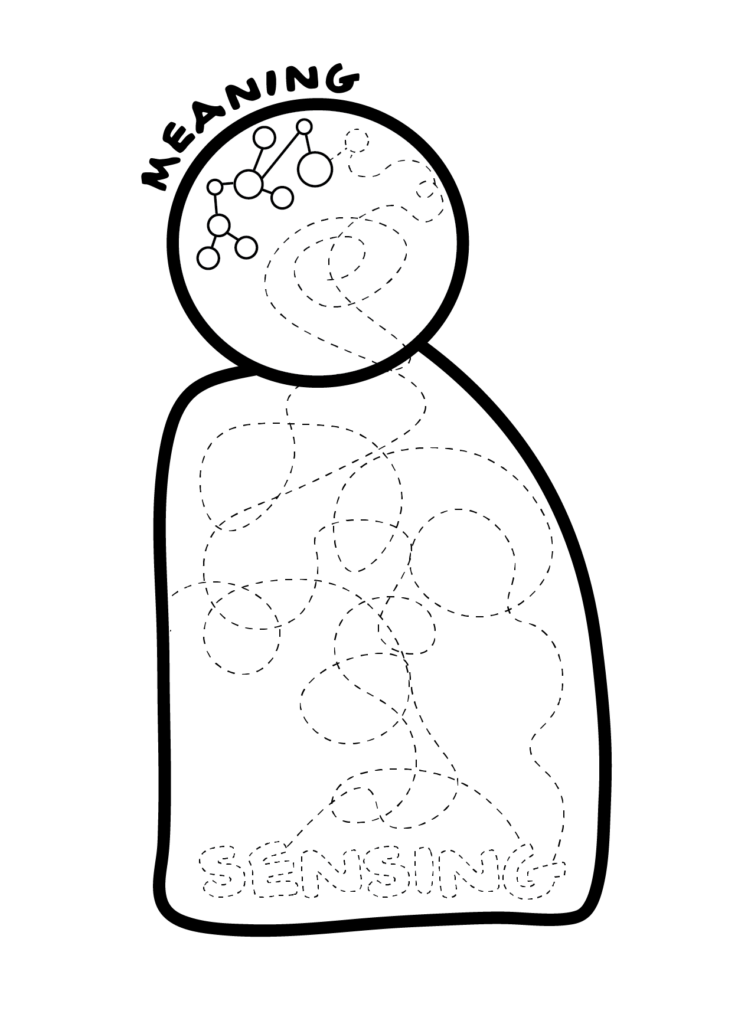
Whether we are interacting with other humans, with the work of others, or working our way through a problem we are solving on our own — we seek meaning through sensemaking to store as information, misinformation and disinformation by adding it to our unique mental model.
- Information is whatever meaning is kept on cognitive record in our mental model after whatever sense has been made.
- Misinformation is created when we don’t get the intended meaning and understand something differently than intended.
- Disinformation is created when we sense the meaning as intended, but it was delivered with an intent to deceive or manipulate.
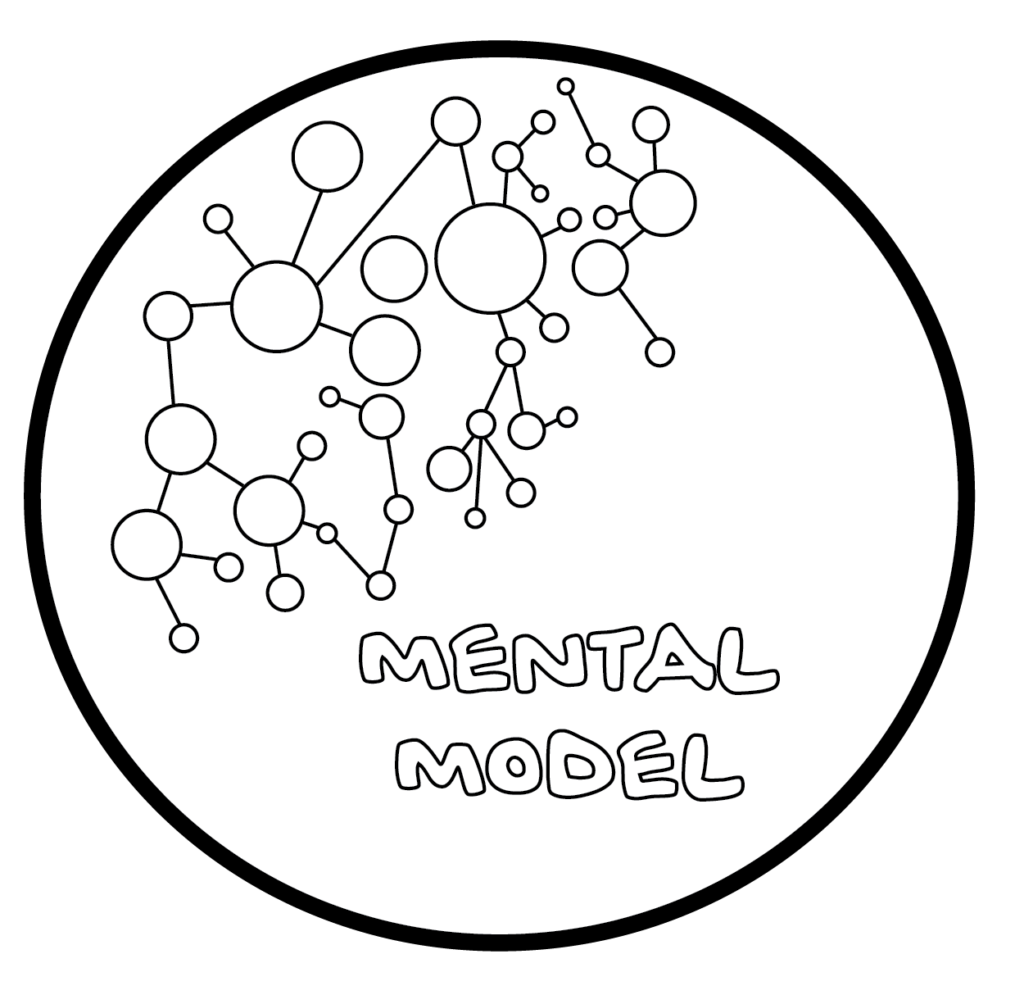
You can think of a mental model like a gigantic map of all the information, misinformation and disinformation you have ever collected in your lifetime. You can’t see this map, nor grasp or plumb its depths and complexities, but you use it to make every decision you make, and it impacts how you make sense of anything you sense of.
In other words, when we are making things for other humans to use or understand we are playing in the mushy space of interpretation, meaning and information.
You: Can we manufacture interpretation, meaning or information for other people?
Me: Nope, sorry friend.
You: Can we make things we have high confidence will be meaningful and be interpreted into meaning worth storing?
Me: Absolutely yes, keep reading.
How to Make Meaning in Seven Steps
What if I told you that it only takes seven steps to make meaning? But I also in the next breath point out that I never said those were seven SIMPLE or EASY or TODAYable Steps 🤔
As hard as some of the following steps might feel as I breeze over them, I can assure you they are none-the-less a clear path to making whatever you are working on more meaningful.
1. Understand what you mean when you say what you say
When we use language that we don’t even fully grasp the meaning of we can spread our misunderstanding to others. One of the first steps I recommend is to come to terms with your own use of language today across various touch points.
Actionable (yet not easy) Advice: Start a list of the names of core objects and processes. Point out the times when the term has alternatives based on context, and any impact of the variation (e.g. acronyms, short hands, code names) worth noting. Try to write clear, well-founded, contextualized definitions that other people who work on those objects and processes can also agree with.
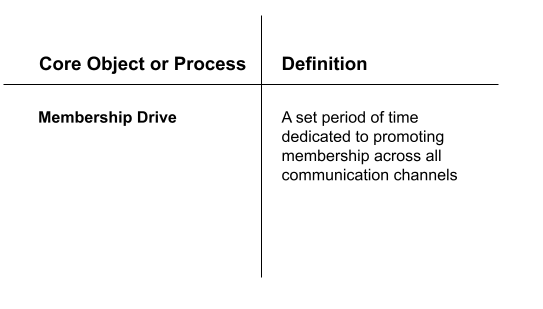
2. Uncover what “they” mean when they say what they say
The important part of this next step is to define who “they” actually are. There are several common definitions of folks you might need to understand better in order to make the meaning you are after in a non-profit environment.
- Potential Supporters: The folks you wish to reach but haven’t yet received support from
- Supporters: The folks who have supported your mission in the past
- Stakeholders: The folks that represent your organization’s founding, operating, funding, influencing, reporting, structuring, and any other mechanisms of power that are at play
In order to make things that are meaningful, we need to understand one of the most fundamental building blocks that makes up the differences amongst us: language.
Actionable (yet not easy) Advice: Using the list of core objects and processes from step 1. Make a row for each and add a column for each audience you have identified. For each object defined on your list, think about the potential or any current changes of label or connotations that each has for each audience.

3. Acknowledge the overlaps, dig deep into the differences
Getting these three audiences to speak the same language isn’t the goal very often in my experience. Instead we often have to make things for those three audiences separately. In order to do that we need to spend time uncovering the differences of term usage, ontological association, or connotation that might exist for these audiences, or groups within them.
With each difference across audiences you have to prioritize the audience(s) that matter most to you, or make the content able to project similar meaning for all audiences.
Actionable (yet not easy) Advice: Use the findings from the exercise on step 2 to dig deeper into the differences and overlaps you found. Ask yourself if the current state is serving each audience as best it could and document any potential evidence of confusion a particular audience has or might have.
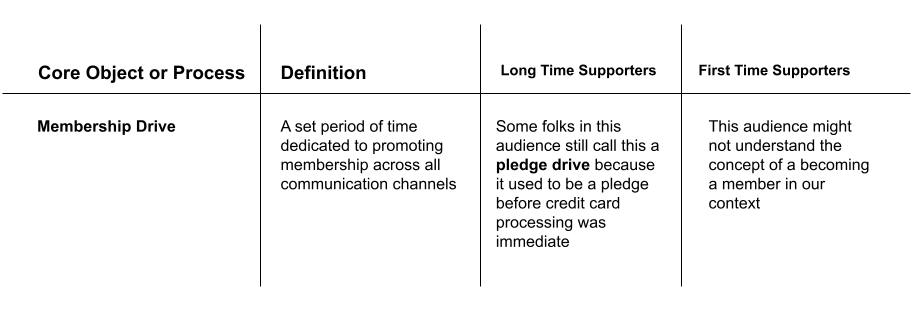
4. Play with ways to explain the differences you have observed
Making visual models can be an incredibly useful exercise for showing (not just telling) people about the observable differences between the ways that various audiences understand or access something. Sticking to simplicity often yields more widespread application, whereas detailed models yield deep conversations when change feels needed, but details are sparse.
Actionable (yet not easy) Advice: Pick one of the differences or overlaps you found in step 3 and create a visual representation of the current state that points out the issue or opportunity. If there is already a desired change-state in mind, this is a good time to visualize that as well. Repeat for any finding from step 3 feels like it needs to be addressed.
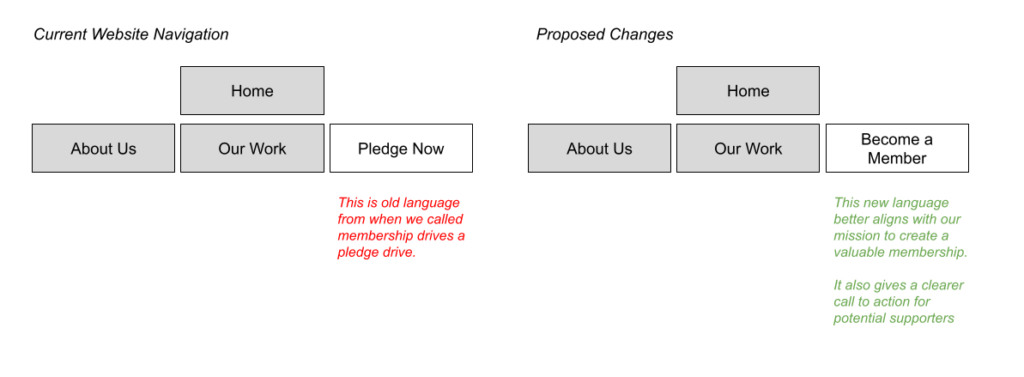
5. Proactively address objections and edge cases.
There will always be objections to handle, and edge cases to address. The most important advice I can give you in this realm is to be as proactive as possible about how you will handle anything that is predictable. It might seem like a downer, but having a pre-mortem to determine what might go wrong and how to deal with it can be incredibly useful in identifying what you might deal with, and where your systems break down.
Actionable (yet not easy) Advice: For each proposed change (or ignored issue) coming out of this process, make a list of the objections each audience might have or edge cases that might arise. Then discuss and document how each objection or edge case that has been identified would be handled (including if it will be ignored). Use this to set guidelines on how to handle different types of objections and edge cases as they arise outside the set that was created proactively. Create scripts or templates for anything that involves delicate communications or changes to process.
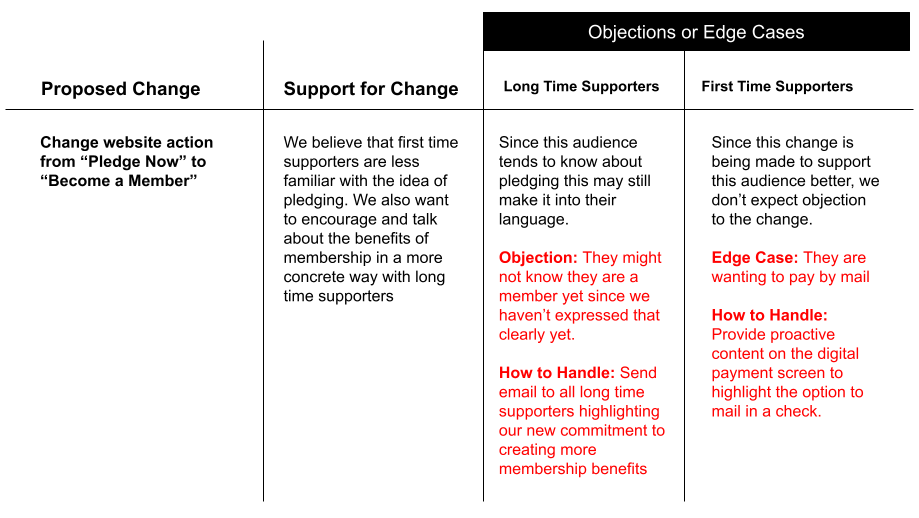
6. Test a potential new shared understanding
Once you feel solid about the new shared understanding, and confident in the meaning that will result from it, spend the time to test with as diverse a representation as represents your goals. Use this exercise to make needed adjustments or additions to the objections and edge cases list from step 5.
Actionable (yet not easy) Advice: Whether you are working on something that warrants full usability testing, or its as simple as pulling some people aside at the next interaction with them – asking for feedback from your target audience is truly the only way to know if what you have been working on is working in your favor.
If you haven’t yet considered investing in user research activities I cannot recommend them more highly. Also just because I left research for step 6 in this process doesn’t mean it couldn’t be a critical addition to any of the steps above. The best approach to research is early and often.
7. Iterate until meaningful
I warned you when we started walking through this process that none of this was simple, easy, or TODAY-able. Just in case you forgot, I saved an entire step at the end to remind you that this process, while helpful, won’t likely yield a magic bullet result. Think of the results of this process as more slow dawning realization and less lightning strike of brilliance.
Actionable (yet not easy) Advice: Whatever the research you have invested in by this point in the process, now is the time to revisit some of those methods to see if your impact to your research baseline is perceivable. Take the time to replicate those methods after iteration to get the best chance at iterating towards improvement.
Now Go Forth and Make More Meaning!
Supporters can only support us if we tell them clearly what it means to support us. As we walked through the seven steps to make more meaning I hope you were able to see where you might have an opportunity to make more meaning for the audiences you serve, or to find the existing leaks of lost meaning that are holding you back from your intentions.
—
If you enjoyed my thoughts on this topic you might also enjoy reading these other related articles:
- Marketing Campaigns Fail When IA is Ignored
- Information Architecture for Navigation
- Structural Arguments for Information Architecture
- What is the return on investing in information architecture?
- Sitemaps for Beginners
If you are ready to go from curious to confidently practicing information architecture in your own context, consider becoming one of my students by registering for The Practitioner’s Guide to How to Make Sense of Any Mess. This course includes access to my LIVE monthly office hours.
If you have a team looking to level-up their information architecture skills, I am currently in development of a long-form course for teams who need to improve IA as a core collaborative skill.
If you want to keep up with the latest from me, join my monthly email list. And if you found this to be of value, I would be so appreciative if you sent this piece to anyone else who might also find value in it.
